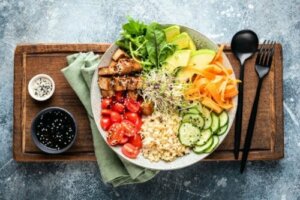Anti-inflammatory Diet to Reduce Uric Acid

Uric acid accumulation in the body can trigger a series of inflammatory changes that can affect your quality of life. Therefore, adopting an anti-inflammatory diet is one of the best ways to reduce uric acid, avoid its effects and stabilize it.
This condition, also called hyperuricemia, is caused by the degradation of purines that are found in some foods. Although the body metabolizes and eliminates them through the work of the kidneys, it sometimes suffers changes because it cannot decompose them correctly.
As a result, kidney stones can be formed. This may also lead to gout and joint pain. In many cases, they are linked to metabolic problems and arterial hypertension.
So, how can you carry out an anti-inflammatory diet to help fight uric acid? It’s important that you know what’s allowed and what’s not. Then, we’ll take a look at an anti-inflammatory diet that can help.
What you should know to reduce uric acid
Taking medication is currently the normal treatment for excess uric acid. However, the best way to stabilize its levels in the blood is through your diet. So, why is this?

The foods in our diet can be helpful or hurtful when dealing with this problem. While some foods will increase the concentration of purines, others will support the metabolic process and will eliminate them from your body.
By carrying out an anti-inflammatory diet, you’ll be able to get the required nutrients for dealing with this condition. So, we suggest avoiding any sources of uric acid, giving priority to alkalizing foods.
The purpose of an anti-inflammatory diet
An anti-inflammatory diet used to treat uric acid has three main objectives: regulate the pH of your urine, control your consumption of purines and decrease your intake of fructose. These will all help facilitate the decomposition of this substance and, therefore, reverse its effects.
Learn how to Relieve Painful Joints with an Herbal Alcohol Ointment
Reduce uric acid by regulating the pH of urine
The kidneys are the organs that are responsible for filtering uric acid from the blood in order to eliminate it through urine. So, when it’s not being controlled, it’s important to alter the pH of your urine to help with its expulsion. How?
- Drink more water and healthy infusions
- Eat more fruit and vegetables
- Reducing your consumption of uric acid or acidic sources such as refined sugars, eggs and animal products (meat, fish)
- Limiting your salt intake and cooking at home
- Completely avoiding alcoholic beverages, including beer and wine
Regulate purine consumption
In all anti-inflammatory diets, you want your purine consumption to be as low as possible. Because of that, it’s important to watch what you’re eating, as well as the cooking method. When boiling foods with purines, a lot of them goes into the water.
So, this is a good way to reduce the purine content of foods, but make sure not to use the water as a broth.
Reduce uric acid by regulating fructose intake
Fructose is metabolized in the body into a type of purine known as xanthine, which will eventually become uric acid. So, we recommended that you limit your fruit consumption to one piece a day. Also, you should opt for fruits with less fructose content such as pineapple, kiwi, mango, watermelon, strawberries, orange, melon, and apricots.

Foods prohibited from an anti-inflammatory diet
Many of these “forbidden” foods should only be avoided in the event of a gout attack or kidney stones. If you just have high uric acid levels, but do not have any symptoms, these foods are should be limited as much as possible and only eaten in small amounts.
To show you, in detail which foods should be avoided, we have classified them according to their levels of purines:
A high amount of purines (150-800 mg per 100g)
- Fructose, pâtés, offal
- Sardines, anchovies, mackerel
- Prawn, shrimp, cockles, mussels
A considerable amount of purines (70-150 mg per 100g)
- Beef, ox, pig, boar, quail, partridge
- Lentils, beans
- Large oily fish
Average purine quantity (50-70 mg per 100g)
- Rabbit, chicken, turkey
- Chickpeas, beans, peas, soy
- Cauliflower, mushrooms, spinach, asparagus
Low amount of purines (0-50mg per 100g)
- Fruit
- Tubers
- White or refined grains
- Milk and low-fat derivatives
- Most vegetables (except those previously mentioned)
A model anti-inflammatory diet to reduce uric acid
There are many ways to design an anti-inflammatory diet as a way to treat uric acid. In fact, it’s almost always recommended that you adapt yours to each particular case because the accumulation of uric acid causes different problems.

However, there are simple models that serve as examples to know how meals should be planned. So, below, we’ll share a good option.
Try out these Seven Low-Carb Meals for a Week of Dieting
Breakfast
- Whole grain cereals without sugar, with skim milk
- A cup of fresh strawberries
- Coffee and water
Lunch
- A small portion of baked chicken breast on a wheat roll with mustard
- Mixed salad with vinegar dressing and olive oil
- Skim milk
Snack
- A cup of fresh cherries
- A glass of water or tea
Dinner
- A portion of roasted salmon
- Roasted or steamed green beans
- Half a cup of whole-grain pasta with olive oil and lemon pepper
- An infusion or low-fat yogurt
In conclusion
Following an anti-inflammatory diet can limit the production of uric acid in the body and promote its proper elimination. Although it doesn’t serve as a cure for the problems caused by this substance, it’s a great ally to any treatment.
Mayo Clinic experts have also shared some interesting guidelines about the gout diet that you can check out.
All cited sources were thoroughly reviewed by our team to ensure their quality, reliability, currency, and validity. The bibliography of this article was considered reliable and of academic or scientific accuracy.
- Izzedine, H., & Deray, G. (2011). Acide urique et fonction rénale. Revue Du Rhumatisme (Edition Francaise). https://doi.org/10.1016/S1169-8330(11)70026-6
This text is provided for informational purposes only and does not replace consultation with a professional. If in doubt, consult your specialist.








